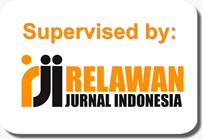CITY BRANDING KECAMATAN PONCOKUSUMO SEBAGAI KAWASAN DESA WISATA DI KABUPATEN MALANG
Abstract
This study aims to find a structured city branding model of Poncokusumo District of Malang Regency as a tourism village area in Malang Regency by using aspects / dimensions of city branding by Kavaratzis (2004). This analysis is carried out in 2 stages, namely primary communication and secondary communication. The point of view in this study uses the point of view of communication which views a brand as part of public relations. Researchers used qualitative descriptive methods with data collection techniques, in-depth interviews, observation, and documentation. The informant selection technique uses a purposive sampling technique while the data analysis technique uses Miles & Huberman, consist of data reduction, data presentation, and data verification and data validity using source triangulation. The results of this study indicate that the structured city branding model through the Kavaratzis city branding concept conducted by the Malang District Culture and Tourism Office has not yet been found. This is because the Malang District Culture and Tourism Office has not yet developed an effective primary communication where the official as the program owner can clearly communicate the concept of a tourism village and its development. Secondary communication in the development of Poncokusumo Subdistrict as a tourist village area experienced a problem, which is the absence of special publications by the Culture and Tourism Office of Malang Regency, so that the popularity of Poncokusumo Subdistrict as a tourist village area could not reach the Top of Mind. The Poncokusumo District Brand as a tourist village area is less known because there is no special event that lifts the tourism village and the publication is less so that Poncokusumo District as a tourist village area is less known by the public.
Keywords: City Branding, Poncokusumo, Tourism Village
Full Text:
PDFReferences
Bungin, B. (2011). Metodologi penelitian kuantitatif. Jakarta: Kencana.
Creswell, J. (2002). Desain penelitian. Jakarta: KIK Press.
Gelder, S. (2005). Global brand strategy. London: Koganpage
Gelgel, I. (2006). Industri pariwisata indonesia dalam globalisasi perdagangan jasa (GATS – WTO) Implikasi Hukum dan Antisipasinya. Bandung: PT Refika Aditama.
Harrison, L. (2007). Metodologi penelitian politik. Jakarta: Kencana Pernada Media Group.
Hidayat, N. (2013). Paradigma dan metodologi penelitian sosial empirik klasik. Jakarta: Departemen Ilmu Komunikasi FISIP Universitas Indonesia.
Kartajaya, H. (2010). Brand Operation. Esensi Erlangga Group.
Kotler, P. & Gary A. (1997). Dasar-dasar pemasaran; principles of marketing, seventh wdition, alih bahasa alexander sindoro. Jakarta: Prenhallindo.
Kotler, P. & Kevin, L. (2006). The official MIM academy course book: marketing management, twelve edition. New Jersey: Prentice Hall.
Kriyantono, R. (2007). Teknik praktis riset komunikasi. Jakarta: Kencana
Mill, R. (1990). The tourism international bussiness edisi bahasa indonesia. Jakarta: PT Raja Grafindo Persada.
Moleong, L. (2004). Metode penelitian kualitatif. Bandung: Remaja Rosdakarya
Purhantara, W. (2010). Metode penelitian kualitatif untuk bisnis. Yogyakarta: Graha Ilmu.
Rainisto, S.K. (2003). Success Factors of Place marketing: A study of place marketing practices in Nothern Europe and the United States. Doctoral Disertation. Helsinki: University of Technology, Institute of Strategy and International Business.
Saleh, M. (2010). Public Service Communication. Malang: UMM Press.
Simamora, B. (2001). Remarketing for bussiness recovery, Sebuah pendekatan riset. Jakarta: PT Gramedia Pustaka Utama.
Simamora, Bilson. (2003). Memenangkan Pasar dengan Pemasaran Efektif & Profitable, cetakan pertama, Jakarta: PT Gramedia Pustaka Utama.
Strauss, Anselm & Juliet Corbin. (2009). Dasar-dasar Penelitian Kualitatif, Yogyakarta: Pustaka Belajar.
Sugiyono. (2009). Metode Penelitian Kuantitatif dan Kualitatif, Bandung: CV Alfabeta
Surrachman S.A. (2008). Dasar-dasar Manajemen Merek; Alat Pemasaran untuk Memenangkan Persaingan. Malang: Bayu Media Publishing.
Susanto, A. B & Wijanarko, H. (2004). Power Branding: Membangun Merek Unggul dan Organisasi Pendukungnya, Jakarta: Quantum Bisnis & Manajemen.
Sya, L. S. (2005). Branding Malasia, Petaling Jaya: Oak Enterprise.
Temporal, Paul & K. C. Lee. (2002). Hi-Tech Hi-Touch Branding, Jakarta: Salemba Empat.
Tisnawati. E & Saefullah, K. (2005). Pengantar Manajemen, Jakarta: Kencana Prenada Media Group
Yananda, Rahmat & Ummi, Salamah. (2014). Branding Tempat: Membangun Kota, Kabupaten, dan Provinsi Berbasis Identitas, Jakarta: Makna Informasi.
JURNAL
Ascholani, Chasan. (2010). Membangun Desa Wisata sebagai Upaya Pengurangan Kemiskinan. Kabar Indonesia.
Asworth, Gregory & Mihalis Kavaratzis. (2009). Beyond the Logo: Brand Management for Cities dalam Brand Management, Vol. 16.
Edvinson, L. (2006). Aspect on the City as a Knowledge Tool. Journal of Knowledge Management , Vol. 10 No. 5.
Florek, M & Canejo, F. (2007). Export Flagship in Branding Small Developing Countries: The Cases of Costarika and Moldova. Journal of Place Branding and Public Diplomacy, Vol. 3 No. 1.
Hankinson, G. (2007). The Management of Destination Brands: Five Guiding Principles Based on Recent Development in Corporate Branding Theory; Journal of Brand Management, Vol. 14 No. 3.
Kavaratzis M. (2004). From City Marketing to City Branding: Towards a Theoritical Framework for Developing City Brands. Place Branding, 1 (1).
Nuryanti, Wiendu. (1993). Concept, Perspective, and Challage, Makalah bagian dari Laporan Konferensi Internasional mengenai Pariwisata, Budaya, Yogyakarta: Gadjah Mada University.
OECD. (2007). Competitive Cities: A New Enterprenurial Paradigm in Spatial Development. OECD Publishing, Paris.
Ooi, Can-Seng. (2010). Familiarity and Uniqueness: Branding Singapore as a Revitalized Destination. Copenhagen Scholl Bussiness.
DOI: https://doi.org/10.31846/jae.v8i1.286
Refbacks
- There are currently no refbacks.

This work is licensed under a Creative Commons Attribution-NonCommercial-NoDerivatives 4.0 International License.
e-Jurnal Apresiasi Ekonnomi Indexed by:












